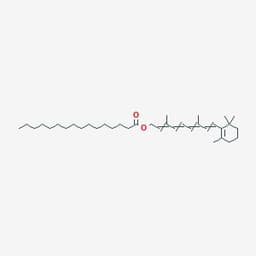Retinyl Palmitate

Summary: A storage form of vitamin A with low potency but higher stability than retinol.
Published on: 11/08/2025
Retinyl palmitate is an ester of retinol and palmitic acid—a storage form of vitamin A that is naturally found in the skin and liver. In skincare, it functions as a pro-retinoid, meaning it must first be converted into retinol, then retinal, and finally retinoic acid to exert its biological effects [1,2]. This multi-step process makes retinyl palmitate less potent than retinol [1,2].
How It Compares to Retinol
| Feature | Retinol | Retinyl Palmitate |
|---|---|---|
| Potency | High | Low |
| Conversion | Retinol → Retinal → RA | Palmitate → Retinol → Retinal → RA |
| Stability | Low | Slightly Higher |
| Regulatory limits (EU) | 0.3% RE for face/leave-on | Same (0.3% RE max) [3] |
RA = Retinoic Acid
Retinyl palmitate is slightly more stable than retinol under oxidative conditions, according to the European Scientific Committee on Consumer Safety (SCCS). However, it still undergoes significant degradation in the presence of light and heat unless protected by stabilizing agents [3].
As for efficacy, the question of whether retinyl palmitate delivers meaningful results in vivo remains controversial. While it acts as a storage form of vitamin A and is enzymatically hydrolyzed in the skin to release retinol [1], its multi-step conversion means its impact on wrinkle depth or pigmentation is likely minimal at typical cosmetic concentrations.
One preclinical study in keratinocytes found that retinyl palmitate alone did not upregulate retinoid-responsive genes, but when combined with retinol, it enhanced retinol’s effects and reduced UVB-induced DNA damage [4]. In contrast, another preclinical study reported that retinyl palmitate alone reduced collagen degradation, suppressed UVB-induced inflammatory cytokines and improved cell migration and viability following UV damage [5]. These studies suggest retinyl palmitate may have some independent photoprotective and anti-inflammatory activity in addition to potential synergistic effects when combined with retinol.
Controversy: Photocarcinogenesis in Animal Studies
In 2010, a draft report from the U.S. National Toxicology Program (NTP) found that topical retinyl palmitate accelerated photocarcinogenesis in hairless mice when combined with UV exposure [6]. The Environmental Working Group (EWG) raised public concerns about the photocarcinogenic potential of retinyl palmitate in sunscreens, referencing those rodent studies by the U.S. National Toxicology Program (NTP).
However, dermatology experts have criticized the interpretation of these findings, noting that the UV exposure conditions used in the NTP study were excessive and not representative of real-world use. They also argued that the in vitro results from that study may not reflect the complex antioxidant environment of human skin, and that there is no clinical evidence in humans supporting photocarcinogenicity from retinyl palmitate in sunscreens [7]. Major regulatory bodies, including the FDA and EU SCCS, have reviewed the data and did not ban the ingredient, though they recommend concentration limits to ensure overall vitamin A exposure remains safe [4].
Conclusion
Retinyl palmitate is a low-potency, stable vitamin A derivative; while its standalone efficacy is limited, it may enhance retinol’s effects and offer some photoprotective benefits. Despite past controversy over photocarcinogenicity in animal studies, no human risk has been confirmed, and regulatory agencies in the US, EU, and other regions continue to allow its use within established safety limits.
References
-
Mukherjee, S., Date, A., Weindl, G., et al. (2006). Retinoids in the treatment of skin aging: An overview of clinical efficacy and safety. Clinical Interventions in Aging, 1(4), 327–348.
https://pmc.ncbi.nlm.nih.gov/articles/PMC2699641/ -
Zasada, M., Budzisz, E. (2019). Retinoids: Active molecules influencing skin structure formation in cosmetic and dermatological treatments. Advances in Dermatology and Allergology, 36(4), 392–397.[https://pmc.ncbi.nlm.nih.gov/articles/PMC6791161/]
-
Scientific Committee on Consumer Safety (SCCS). (2022). Opinion on vitamin A (retinol, retinyl acetate, retinyl palmitate) – SCCS/1639/21.
https://ec.europa.eu/health/system/files/2023-08/sccs_o_261.pdf -
Zhong, J., et al. (2025). Synergistic effects of retinol and retinyl palmitate in alleviating UVB-induced DNA damage and promoting the homologous recombination repair in keratinocytes. Frontiers in Pharmacology, 16:1562244.
https://pmc.ncbi.nlm.nih.gov/articles/PMC12058701/ -
Shu, M. et al. (2023). Efficacy and mechanism of retinyl palmitate against UVB-induced skin photoaging. Frontiers in Pharmacology, 14, 1278838. https://pmc.ncbi.nlm.nih.gov/articles/PMC10622759/
-
National Toxicology Program (NTP). (2012). NTP Technical Report on the Photocarcinogenesis Study of Retinyl Palmitate (CAS No. 79-81-2) in B6C3F1 Mice (Simulated Solar Light and Topical Application Studies). NTP Technical Report 568. U.S. Department of Health and Human Services, Public Health Service.
https://ntp.niehs.nih.gov/ntp/htdocs/lt_rpts/tr568_508.pdf -
Wang, S. Q., Dusza, S. W., & Lim, H. W. (2010). Safety of retinyl palmitate in sunscreens: A critical analysis. Journal of the American Academy of Dermatology, 63(5), 903–906.
https://www.jaad.org/article/S0190-9622(10)00850-9/abstract